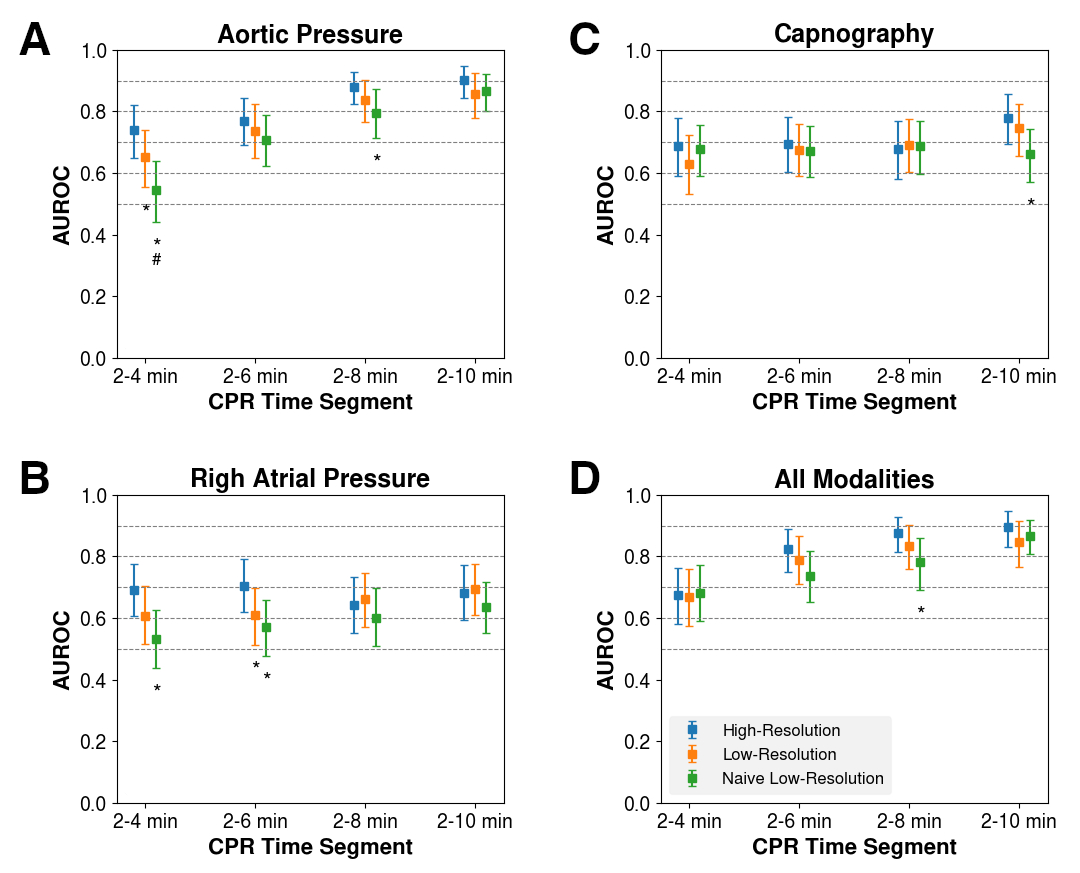Final ID: Su1301
Comparison of Multimodal High- and Low-Resolution Time Series for ROSC Prediction During CPR Using Machine Learning
Abstract Body: Introduction: Early and accurate prediction of return of spontaneous circulation (ROSC) during cardiopulmonary resuscitation (CPR) is vital for guiding clinical decisions that improve patient outcomes. Our previous work demonstrated that low-resolution (one sample every 15 s) multimodal physiological times series could effectively predict ROSC, with the best results achieved by combining all modalities over the entire CPR period. This study explores whether higher resolution time series can improve ROSC prediction, particularly in early CPR or using individual modalities.
Hypothesis: High-resolution physiological time series during CPR provide superior ROSC prediction compared to low-resolution time series.
Methods: In a pediatric swine model (sus scrofa, 8-12 kg) of asphyxia-associated cardiac arrest, aortic pressure (AoP), right atrial pressure (RAP), capnography (Cap), and electrocardiogram (ECG) waveforms were continuously acquired (100 Hz) during CPR. Three types of time series were derived: 1) high-resolution: beat-by-beat (compression-by-compression) measures of systolic, diastolic, mean, pulse, and coronary perfusion pressure (from AoP and RAP), end-tidal CO2 and power in the 4-8 Hz band (from Cap), and amplitude spectrum area (from ECG); 2) low-resolution: 15 s block-averages of beat-by-beat series; 3) naïve low-resolution: 15 s block averages of AoP, RAP, and Cap. Features were extracted and used to train extreme gradient boosting models for ROSC prediction. To examine time-dependence, time series data during the first 10 min of CPR were analyzed in 2-4, 2-6, 2-8, and 2-10 min segments, excluding the first two minutes (chest molding). Models were trained for each modality (AoP, RAP, Cap, and their combination), resolution (high-resolution, low-resolution, naïve low-resolution) and CPR segment. Performance was evaluated by the area under the receiver operator characteristic curve (AUROC), with statistical differences assessed by DeLong’s test and corrected for false discovery rate.
Results: High-resolution AoP and RAP time series outperformed their low-resolution series during early CPR (2-4 min). However, when all modalities were combined, low-resolution time series achieved comparable ROSC prediction.
Conclusion: High-resolution time series improve ROSC prediction in early CPR. Individually, AoP demonstrated the most robust performance. These findings will guide the optimization of hemodynamic monitoring during CPR to improve resuscitation success.
Hypothesis: High-resolution physiological time series during CPR provide superior ROSC prediction compared to low-resolution time series.
Methods: In a pediatric swine model (sus scrofa, 8-12 kg) of asphyxia-associated cardiac arrest, aortic pressure (AoP), right atrial pressure (RAP), capnography (Cap), and electrocardiogram (ECG) waveforms were continuously acquired (100 Hz) during CPR. Three types of time series were derived: 1) high-resolution: beat-by-beat (compression-by-compression) measures of systolic, diastolic, mean, pulse, and coronary perfusion pressure (from AoP and RAP), end-tidal CO2 and power in the 4-8 Hz band (from Cap), and amplitude spectrum area (from ECG); 2) low-resolution: 15 s block-averages of beat-by-beat series; 3) naïve low-resolution: 15 s block averages of AoP, RAP, and Cap. Features were extracted and used to train extreme gradient boosting models for ROSC prediction. To examine time-dependence, time series data during the first 10 min of CPR were analyzed in 2-4, 2-6, 2-8, and 2-10 min segments, excluding the first two minutes (chest molding). Models were trained for each modality (AoP, RAP, Cap, and their combination), resolution (high-resolution, low-resolution, naïve low-resolution) and CPR segment. Performance was evaluated by the area under the receiver operator characteristic curve (AUROC), with statistical differences assessed by DeLong’s test and corrected for false discovery rate.
Results: High-resolution AoP and RAP time series outperformed their low-resolution series during early CPR (2-4 min). However, when all modalities were combined, low-resolution time series achieved comparable ROSC prediction.
Conclusion: High-resolution time series improve ROSC prediction in early CPR. Individually, AoP demonstrated the most robust performance. These findings will guide the optimization of hemodynamic monitoring during CPR to improve resuscitation success.
More abstracts on this topic:
Association between dynamic cerebral perfusion indices by NIRS and cerebral microvascular flow during CPR in a porcine cardiac arrest model
Kiguchi Takeyuki, Nishioka Norihiro, Kamo Wataru, Ninomiya Kouhei, Makino Yuto, Kamada Tsuyoshi, Maeda Hideki, Iwami Taku
A Case of Successful Resuscitation After Out-of-hospital Cardiac Arrest Caused by Undiagnosed Pheochromocytoma-induced CardiomyopathyHatakeyama Toshihiro, Suetsugu Yusuke, Watanabe Kaoru, Matsushima Hisao


